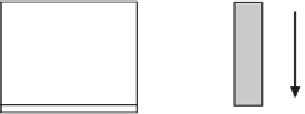Civil Engineering Reference
In-Depth Information
3.8.6.3 Resistance to Vertical Shear
To check the safety of composite plate girders against shear stresses,
welded structural steel section with a solid web, which may be stiffened.
be taken as the resistance of the structural steel section
V
pl,a,Rd
unless the
value for a contribution from the reinforced concrete part of the beam
has been established. The design plastic shear resistance
V
pl,a,Rd
of the struc-
tural steel section should be determined as previously detailed. The shear
buckling resistance
V
b,Rd
of an uncased steel web should be determined
be taken of a contribution from the concrete slab in the calculation of the
shear buckling resistance.
the shear resistance
V
Rd
given by
V
pl,Rd
or
V
b,Rd
, whichever is the smaller,
allowance should be made for its effect on the resistance moment. For cross
sections in class 1 or 2, the influence of the vertical shear on the resistance to
bending may be taken into account by a reduced design steel strength (1
r
)
2
75
Þ
and
V
Rd
is the appropriate resistance to vertical shear. For cross sections in
stresses of the composite section. No account should be taken of the change
in the position of the plastic neutral axis of the cross section caused by the
reduced yield strength when classifying the web.
r¼
2
V
Ed
=
ð
V
Rd
1
Þ
ð
3
:
b
eff
0.85
f
cd
−
M
Rd
(1-
ρ
)
f
yd
V
Ed
+
f
yd
Figure 3.31 Plastic stress distribution modified by the effect of vertical shear according
to EC4 [
3.6
].

























Search WWH ::

Custom Search